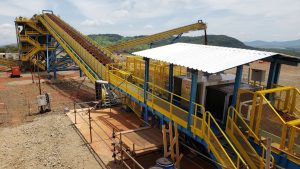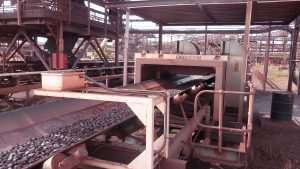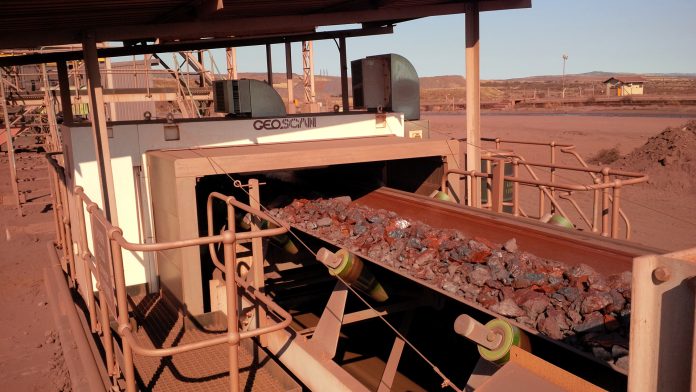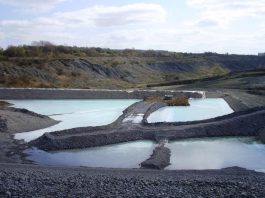Digitalising conveyed ore in real-time is proven to improve processing operations, and not just by a few percentage points.
Few processing operations in the minerals industry (and others) utilise proven bulk measurement technology to reduce the impact of feed quality variability in process feed. Feed grades can be increased by 5-20%, metal recoveries can be improved by up to 15%, and products can be increased by 20% for the same plant throughput. These are step changes achieved in real life by mining companies that have adopted high-performance, real-time, representative measurement technologies on primary crushed rock.
Digitalisation: Rocks2Data
GEOSCAN uses high-specification Prompt Gamma Neutron Activation Analysis (PGNAA) in many commodities and applications and has proven unique in providing high-quality representative measurement data. Measurement for bulk ore sorting in base metals, industrial minerals and PGMs has been particularly successful. Ore grade is controlled by diverting waste parcels from the conveyed flows, controlling blends from different sources, and diverting material that does not need processing.
GEOSCAN GOLD, which is the only system to measure gold grade directly, has been supplied to gold mines in North America, Latin America, Australia, Asia and Africa and is achieving expected performances. A suite of elements is measured over every 30 seconds of conveyed flow, and gold is directly measured over 5-10 minute increments at unmatched precisions (to 0.2 ppm Au).

Representative measurement data is used in feed-forward control, feedback to mining and metal accounting and ore reconciliation, and in applications mentioned above. The analyser measures elements in primary crushed rock (generally up to -350mm) in conveyed flows at <100 tph to >10,000 tph, irrespective of belt speed, particle size, mineralogy, dust, moisture, segregation or layering. The calibrations cater for changes in flow rate.
Digital data synergies
Representative elemental analysis is combined with moisture and next-gen PSD analysis technologies. Scantech’s READIMOIST TBM200 series transmission microwave moisture analysers have proven to be the most effective and reliable in the market, with expected performance usually achieved within two days of commissioning. Fragmentation data (particle size distribution (PSD)) from SizeScan is generated using innovative 3D infrared camera technology and advanced proprietary algorithms. The SizeScan requires only a one-off calibration after installation. Data from SizeScan is generated every two seconds and transmitted directly to the plant control system, which is owned by the site without any access limitations or cost over its long life. All three systems can be installed on a 5-7m long section of conveyor.
ESG and economic benefits
Not all technology users are forthcoming with benefits received, and some are very guarded, believing certain technologies provide competitive advantages. Nonetheless, the following have been achieved and advised:
- 44,000 t CO2 e/year reduction and $5m/year saving by diverting five million tonnes of product quality iron ore annually on average to bypass a beneficiation plant
- 40,000 t CO2 e/year saving by diverting 14% of the mine output (not processing waste) from a copper ore conveyor at 1,200 tph feeding a flotation circuit
- A 22% increase in plant output after one month of GEOSCAN operation at a phosphate rock processing plant producing phosphoric acid
- Prevention of furnace freezing events (savings tens of millions of dollars in lost production) by controlling B4 sinter basicity in iron ore at a steel plant.
The benefits outlined above are not comprehensive as they do not include:
- Extensions in tailings dam life by diverting coarse waste instead of generating fine tailings
- Additional revenues through higher quality or quantity product output for the same throughput rate
- Increased contained metal throughput by diverting lower quality material and replacing it with higher quality feed
- Savings in reagent costs, water, electricity, etc, otherwise consumed if the waste had been processed
- CAPEX saving in plant design for smaller beneficiation plants, knowing one-third of mine output will bypass processing
- Reduced processing costs per tonne of product for non-iron ore examples
- Savings on equipment wear and tear

In some cases, additional costs may be incurred, such as additional waste material transportation; however, the net benefits still occur, and paybacks are typically in a few weeks or months.
Due diligence
Effective technology selection requires a good understanding of differentiators between vendors and offered equipment. As the leader in the minerals sector, Scantech can assist mining companies in reducing procurement and operational risk by sharing proven successes, technical papers, case studies published by clients, and unique measurement capabilities. Scantech’s analysers and support systems are customised to commodities, applications, and regions to ensure the highest implementation success rate.
Quality support
Scantech analysers are supported through remote access, which reduces customer costs. None of the systems has wear components, and mechanical maintenance is virtually eliminated. Qualified Scantech service engineers in each region, backed up by a centrally located team of specialist calibration staff, provide any required ongoing operational support.
Please note, this article will also appear in the 19th edition of our quarterly publication.









